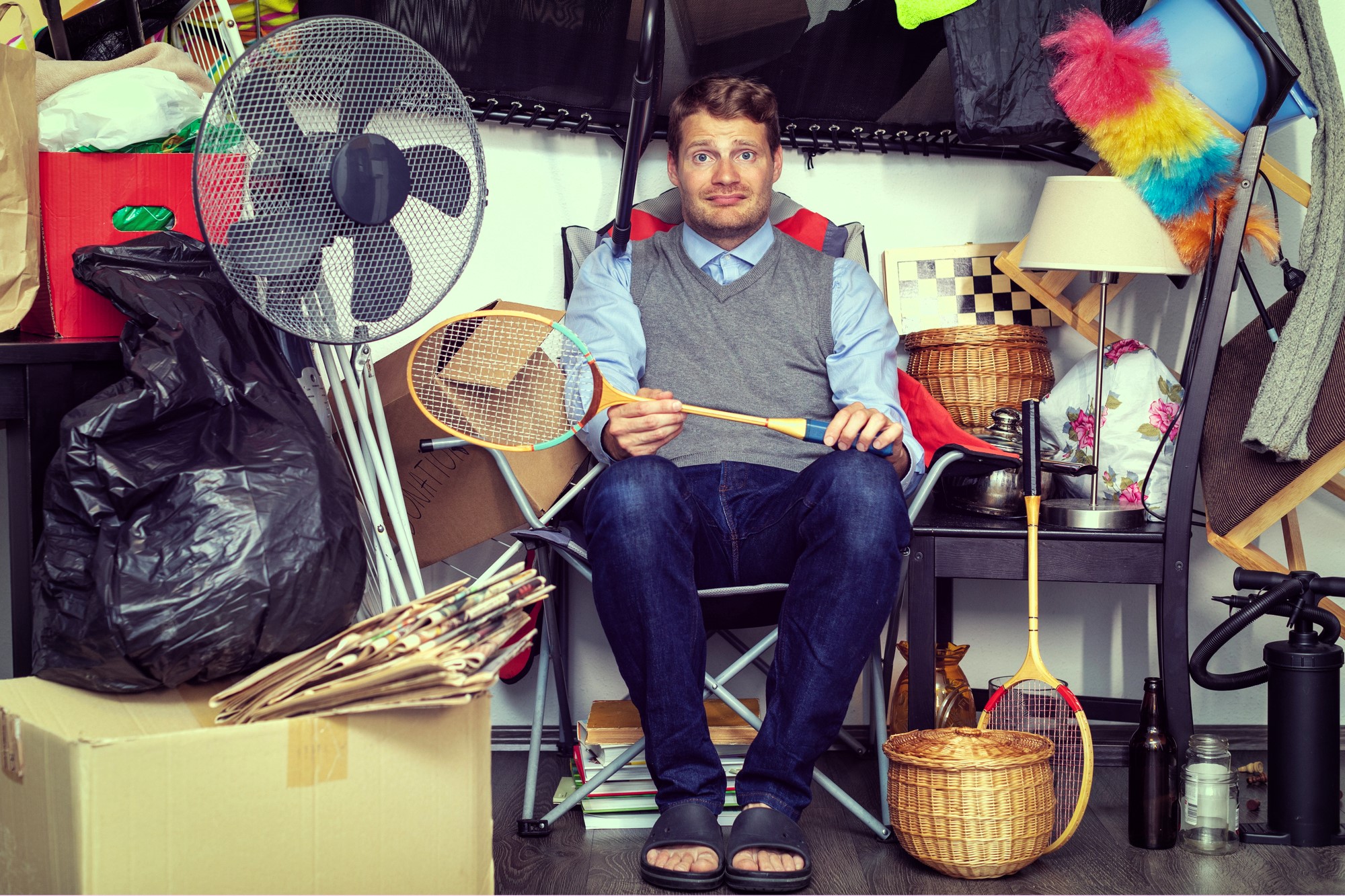Maybe you’re looking around yourself and realize that you haven’t been able to see the floor in months.
Or perhaps you don’t have an inch of clear counter space to work on and you’re not sure when that happened but it’s starting to upset you on some level.
The accumulation of “stuff” doesn’t just happen overnight. Hoarding tendencies develop over the course of several months – even years.
Once that ball is rolling, it’s difficult to stop it. Difficult but not impossible.
Fortunately, if you’re reading this article, it means that you realize there’s something not quite right here, and you’d like help to figure out why it’s happening, and what to do about it.
The good news is that you can absolutely curb hoarding before it gets out of control. It may not be easy, but it’s doable.
The key is to understand your subconscious motivations for doing so. From there, you can determine the steps you need to get a handle on things.
Speak to an accredited and experienced therapist to help you overcome your hoarding tendencies. You may want to try speaking to one via BetterHelp.com for quality care at its most convenient.
Why does hoarding happen?
A 2012 study from Harvard has shown that hoarding is a strong subtype of obsessive-compulsive disorder (OCD). Michael Jenke, a Harvard psychiatry professor and OCD expert, says that: “Hoarders have great difficulty making decisions, especially around the value of their possessions.”
It would appear that people who have hoarding tendencies develop a strong emotional connection to their possessions. This often stems from a deep-seated pain that they’re having difficulty working through.
Instead, they redirect their energy so they don’t have to deal with the hurt. They transfer their attentions to inanimate objects instead.
This makes these items appear to be much more valuable than they actually are. The perceived value of these objects causes hoarders a great deal of anxiety when it comes to getting rid of them.
They feel like they’ll be losing something important that they’ll undoubtedly need at some point in the future. They get worried and upset about letting them go.
If you feel like you’re heading down this road and want to curb your hoarding tendencies before they get out of control, you can consider taking the following steps.
1. Analyze what it is you’re hoarding, and why.
First and foremost, it’s important to determine whether you’re actually hoarding, or being diligent about being prepared for a dire situation.
The key difference between collectors or preppers and those who are considered hoarders is the items that they’re hoarding. For example, collectors might have a wide range of theme-related items. They might have entire rooms dedicated to My Little Pony or Avengers paraphernalia. They could be avid craftspeople who take full advantage of art supply or tool sales for items they could put to good use.
Preppers often stockpile food and survival items they might need in emergencies. They’ll clip coupons so they can buy extra canned goods, have a year’s worth of bottled water in the garage, possibly even a bunker dug in the back garden.
In contrast, hoarders hold on to all kinds of things that don’t have any tangible value – even to the person hoarding them. They might save clothes that no longer fit them, newspapers printed years before, expired food items, used plastic spoons, etc.
Take a look at some of the things you’re holding on to, and be completely honest with yourself about why you haven’t gotten rid of them. Hoarders develop strong emotional ties with items for a wide variety of reasons and thus have severe difficulty parting from them.
As an example, someone might hold on to a plastic bag that’s full of holes and utterly un-usable. There’s no reasonable explanation as to why they’d cling to this, but the person kept it because of a sentimental attachment. They had a great day shopping with their best friend, and that was the plastic bag they were given when they bought a new book they liked.
Instead of just remembering that as a good day, they’ve created an emotional bond with an object that reminds them of that experience. To them, discarding the plastic bag would be like throwing that memory away, thus causing them a great degree of emotional distress. They might also be afraid of hurting that friend’s feelings by discarding this item.
2. Note when the hoarding tendencies began and what might have triggered them.
In addition to OCD being a major causal factor of hoarding disorder, hoarding behavior often stems from trauma.
Let’s say an elderly person was traumatized by the loss of a beloved pet cat. Maybe it got seriously ill and died, or they saw it get hit by a car and dying horribly. They may try to make up for and overwrite that pain by “rescuing” as many cats as possible.
They’ll take in strays, foster kittens, adopt regularly from shelters around them. They’ll accumulate 20, 40, 100 cats (or more), and go into debt trying to feed all of them. Since it takes a great deal of effort to keep your house clean with just a few cats, imagine what kind of state they’d live in with that many running around!
Even though the person who’s hoarding might think that they’re doing a good thing, the opposite is usually true. This is an abusive situation in which the cats are likely sick, malnourished, and trapped in the house without the possibility of escape.
Those animals tend to live in deplorable circumstances, surrounded by piles of feces, and suffering from all kinds of infections and illnesses. Those that don’t starve to death may resort to eating their fallen comrades when they succumb to their fate. Meanwhile, the hoarder is blind to the reality of the situation around them, fully convinced that they’re a savior to these poor babies.
3. Learn to see the story behind your actions.
When you’ve taken stock of what kinds of items you’re hoarding, you might be able to determine what triggered you to start gathering them.
Here’s another example: an elderly gentleman I knew held on to every newspaper he received for over 30 years. These were ironed and stacked neatly in columns that lined every hallway in the house from floor to ceiling. The spare room was a newspaper archive with barely navigable pathways between them. He would have full-on panic attacks at the thought of letting go of a single issue.
I once asked his wife why he did this and when he started. She explained that his own father had suffered a slow decline with Alzheimer’s and dementia, starting at age 56. Once her husband reached that age, he started to collect newspapers and panicked at the thought of letting go of them. His reasoning was that they would provide him with a sort of memory bank when and if his own failed. He was so terrified of losing his mind, his memory, that he created a form of external hard drive to fall back on.
Go through your things and try to determine when and why exactly you started to stockpile them. You might have an iron-clad memory and remember the precise date and circumstances in which you collected each item. Once you’ve figured out when this started, you can try to unravel what might have initiated this behavior.
4. Take inventory of the items you’re hoarding, with an explanation for each of them.
This will likely take a fair bit of time, but is worthwhile if it helps you to understand your motivations. Since hoarding is a subtype of OCD, this can redirect your compulsions in a healthier, more productive direction.
Start by sitting down in front of one pile of accumulated stuff. Hold a piece in your hands, turn it around, and remember why it is you decided to keep it. Then be realistic with yourself about what you plan on doing with it. Label it with a numbered sticker, and write down that number and explanation in a journal.
Repeat this process with as many of the items in front of you as you can. Then read through the explanations you’ve written down. Ask yourself whether these explanations make rational sense to you. Are the ideas you have about using these items in the future reasonable?
Doing this might help you to glean a much better understanding of where these compulsions are coming from.
One major aspect that often contributes to hoarding is a sense of control. People who feel that they don’t have much control over their lives try to counteract that feeling by controlling items in their environment. They can also try to make up for periods in their lives where they’ve suffered, as in the cat example earlier.
A person who has experienced hunger and scarcity might hold on to rotting food or 99% empty food containers because they can’t bear the thought of discarding foodstuffs in any way. People who are terrified of death often hold on to items as a means of coping with their fear of “letting go.”
As mentioned earlier, recent studies have shown that an overwhelming amount of people with OCD + hoarding tendencies have experienced at least one major life trauma. This could have been losing a parent, losing a child or spouse, or dealing with a life-altering illness or injury.
As a result, the person tries to deal with their loss by trying to fill the painful hole in their hearts with “stuff.” This is a coping mechanism that allows them to avoid facing the real emotional pain they’ve experienced and repressed. They’ve redirected those emotions and are able to control the sense of loss by simply not losing anything ever again.
Another aspect of this type of control is the fear of imminent mortality. Many have an intense fear of death and try to avoid thinking about the subject. When some people come face to face with their own mortality, either through the diagnosis of terminal illness or the reality of advancing age, part of them shuts down.
This can result in hoarding items for projects that they have every intention of doing “one day.” One person might have bins or loose skeins of yarn stacked from floor to ceiling in every room for all the blankets and sweaters they plan to create. Similarly, someone else might have a host of car parts all over the front lawn.
They have many plans and projects in mind, yet deep down they know they’ll never achieve them. Therefore, by keeping them around, they’re clinging to the illusion that there’s still time left.
5. Reorganize and reduce your “stuff” in a way that makes you feel reassured.
If you’ve been holding on to items because you’re afraid of letting go of the memories you’ve associated with them, you can rewire the situation so you transfer the memory into a more tangible, neatly organized space. For example, you can start creating memory books or “scrapbooks.”
Let’s go back to that ripped plastic bag example from earlier. If you have a strong connection to an item like that because of the memories linked to it, then dedicate a beautiful scrapbook page to that day’s memory.
Take a pair of scissors and snip a square from the plastic bag, and glue it onto the scrapbook page. Decorate around it with washi tape, stamps, stickers, illustrations – whatever makes you happiest. Then write down all the details you remember about the experience, from who you were with to what you did and how it all made you feel.
Since that memory (and a piece of the item associated with it) is now set down as a physical memorial, you can discard the rest of the plastic bag. It’s as though you’ve taken a piece of the magic out of it to keep forever, so now you don’t have to hold on to the original.
Every time you do this, you’re eliminating one piece of unnecessary clutter in your space.
This might be more difficult to do if you’ve been hoarding things like construction materials, of course. In a case like this, it might be a good idea to build or buy a shed or other storage container. You could even rent a storage unit, if that’s within your budget. This way, you can move the items you’ve been collecting out of your immediate living space without having to let go of them until you feel ready to do so.
6. Start small.
Do you feel like you might be able to start getting rid of things on your own? If so, don’t make big plans to declutter your entire living room in a single weekend. You’ll likely end up having panic attacks and that’ll make you more hesitant to get rid of anything else.
Choose one small area of your home, like a bathroom countertop.
Do the aforementioned steps and write down the reasons why you’re holding on to the things that are filling up that space. Then rank them in order of importance to you.
Are you holding on to 30-year-old eyeshadow because it’s the same color your deceased mother wore? If you try to wear it, you’ll likely get an eye infection. If you want to hold on to the hue for the sake of memory, you can transfer the pigment to your scrapbook and tape over it so it stays true. Then discard that one single item.
You may have a wave of emotional difficulty doing this, but that’s okay. Sit with that feeling and allow it to wash through you. Have a good cry if you need to, but commit to discarding it. Try not to think of it as “throwing it away,” but making room for a cleaner, healthier living environment.
Then move on to the next item. Repeat this process until you have a few inches of clear space in front of you. Then go get a damp cloth and a cleaning spray in a scent that you like. Citrus scents are known to be uplifting, and they’ll make the entire area smell fresh and clean.
Spray a bit on the countertop and use the damp cloth to scrub around the area until it’s clean. Then take a step back and look at that clean spot in contrast with the rest of the countertop. Ask yourself how that makes you feel, and which of the two areas you’d rather see on a daily basis.
You’ve proven to yourself that yes, you can let go of things that you don’t truly need. And it felt amazing to clear that spot away and clean it properly, didn’t it?
Realizing that letting go of this unnecessary “stuff” isn’t going to damage you can ease a lot of the anxiety you may have been feeling about doing so. That kind of positive reinforcement can do wonders to keep you motivated to continue reducing the clutter around you.
7. Seek professional help.
Even if you’ve managed to start clearing out the stuff you’ve been accumulating, there’s a strong chance that you’ll go back to hoarding things unless you understand why it is you’re doing it, and have some solid coping strategies for curbing that behavior.
It’s great if you’ve been able to take the initial steps on your own, but to stop hoarding on a long-term basis, you’ll likely need some backup.
Hoarding is an extremely difficult form of OCD to work through alone. There is absolutely no shame whatsoever in seeking the help of a trained psychotherapist who can help you work through this.
Not only will they be able to help you determine where this behavior is coming from, they’ll give you solid coping strategies that can stop these impulses before the hoarding gets out of control.
Cognitive behavioral therapy can be of immense help when overcoming hoarding tendencies, especially with the guidance of a good therapist.
If you’d like to get started with therapy, you might wish to try the online service provided by BetterHelp.com. You can talk directly to a trained and experienced therapist from the comfort of your own home.
Click here to learn more or to book a session.
8. Don’t be afraid to lean on friends and family members to help you through this.
Many people with hoarding tendencies become quite reclusive for a number of reasons. Those with spouses or partners might drive their partners away with their behaviors. Those who live alone might be too ashamed of their living environments to have any guests over.
As a result, they can get lonely and isolated. This is intensified if they’ve developed very strong attachments to the items they’ve been collecting. Since letting go of these possessions feels like losing loved ones, they might choose their “stuff” over people if given the ultimatums to do so.
After all, unlike people, their items won’t hurt their feelings, betray their trust, abandon them, or die on them. As long as they’re held on to and kept safe, they’ll do the same for the one hoarding them.
If you feel like you have the mental and emotional clarity to reach out for help, start with those who are closest to you. These are the people who might have tried to talk to you about your hoarding tendencies, only for you to push them away. They care about you, want what’s best for you, and will undoubtedly step up to help you however they can if you just allow them to.
You can stop hoarding before it gets out of control. You can even reverse it if it’s gotten out of hand. The first step is recognizing that it’s a problem, and then taking some of the steps above to start sorting it out.
You can do this, and you don’t need to do it alone.










